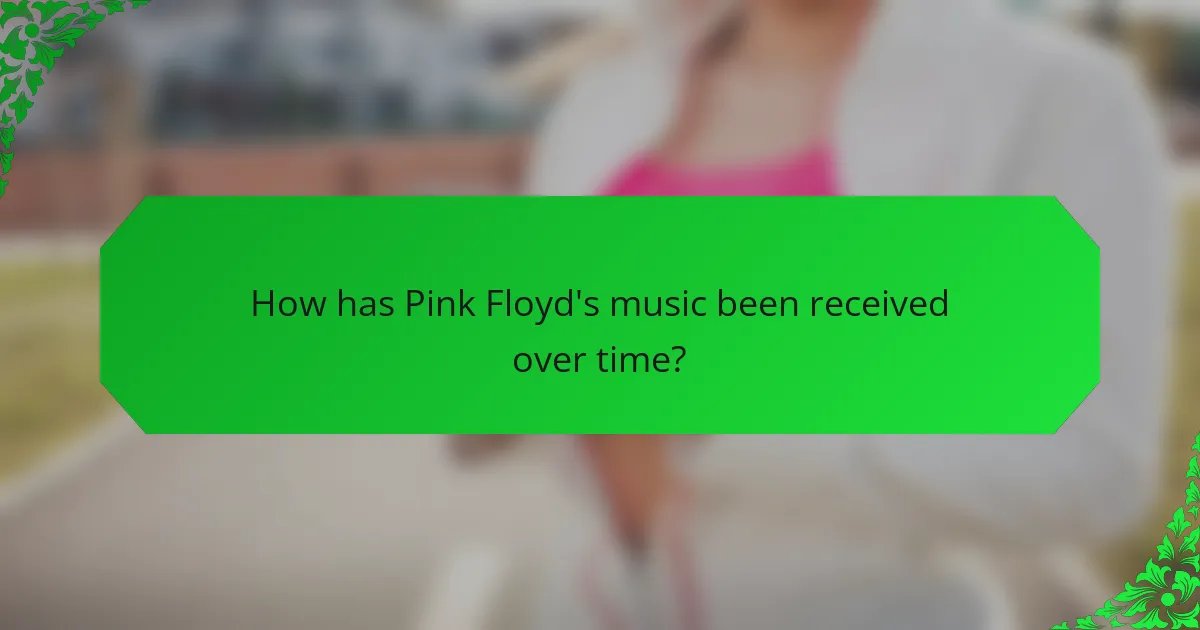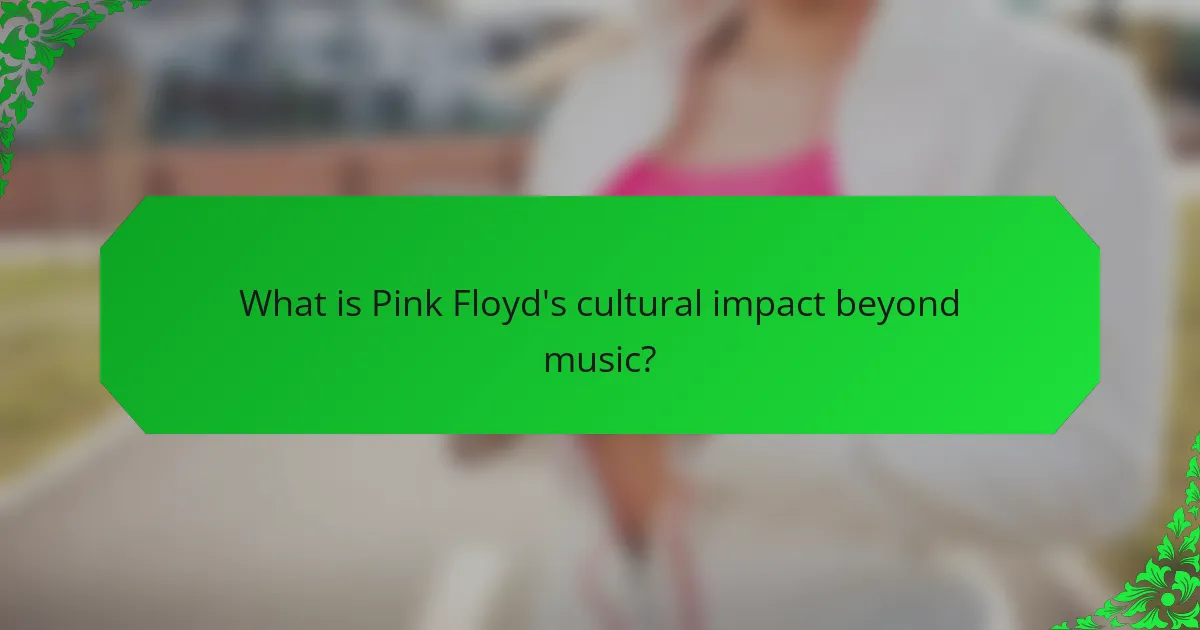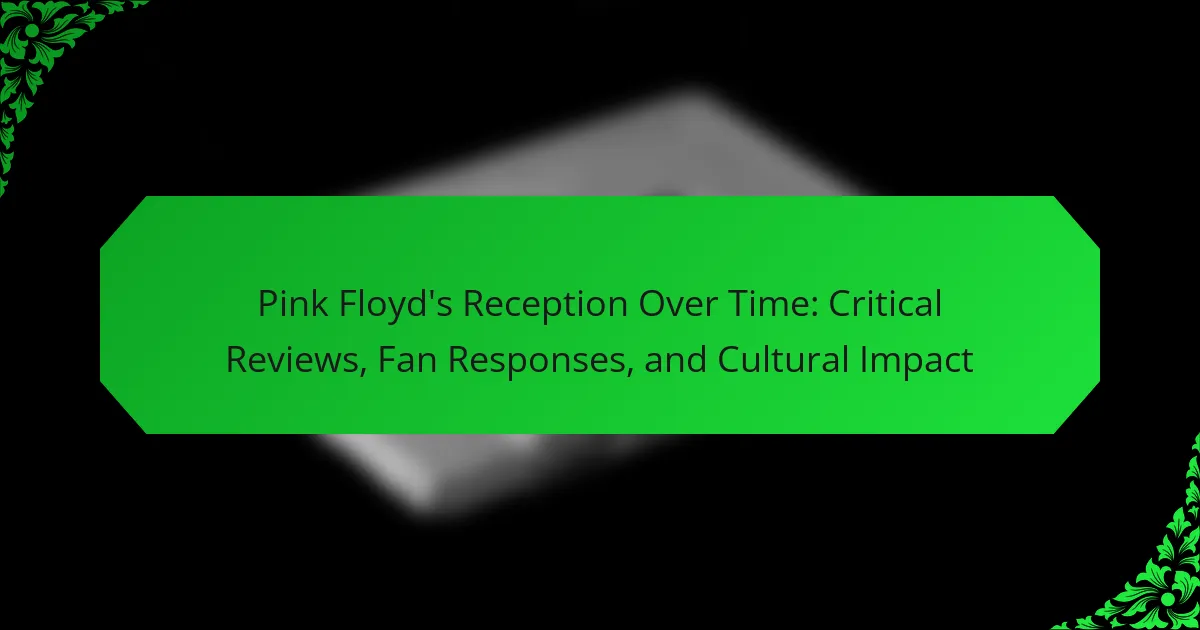Pink Floyd is a critically acclaimed rock band known for their innovative sound and conceptual depth, with significant commercial success highlighted by over 250 million records sold worldwide. Their landmark album, “The Dark Side of the Moon,” has spent an unprecedented 950 weeks on the Billboard 200 chart, showcasing its lasting appeal and the emotional and philosophical themes that resonate with fans. The band’s influence extends beyond music into visual arts and social movements, with their iconic album covers and anti-establishment messages contributing to cultural discourse. Additionally, fan engagement has played a crucial role in shaping Pink Floyd’s legacy, fostering a dedicated community that interprets their complex themes and enhances their cultural impact.

How has Pink Floyd’s music been received over time?
Pink Floyd’s music has been received with critical acclaim and commercial success over time. Their albums, especially “The Dark Side of the Moon,” have consistently ranked among the greatest in music history. The band has sold over 250 million records worldwide, showcasing their widespread popularity. Critics have praised their innovative sound and conceptual depth. The 1973 album “The Dark Side of the Moon” spent 950 weeks on the Billboard 200 chart, illustrating its enduring appeal. Fans have embraced their music for its emotional and philosophical themes. Pink Floyd’s influence extends into contemporary music, with many artists citing them as a major inspiration. Their live performances, particularly the elaborate shows of the 1980s, have also left a lasting cultural impact.
What were the initial critical responses to Pink Floyd’s early albums?
Initial critical responses to Pink Floyd’s early albums were mixed. Their debut album, “The Piper at the Gates of Dawn,” received praise for its innovative sound and psychedelic elements. Critics noted its experimental nature and Syd Barrett’s unique songwriting. However, some reviewers found it disjointed and difficult to appreciate.
Subsequent albums, like “A Saucerful of Secrets,” faced similar critiques. While some applauded the band’s evolution, others deemed it less cohesive than their debut. The overall reception highlighted a divide between those who embraced their avant-garde style and those who preferred more conventional rock.
Despite mixed reviews, Pink Floyd began to build a dedicated fan base. Their live performances garnered attention, contributing to their growing reputation. Over time, the band’s experimental approach would come to be recognized as groundbreaking in the rock genre.
How did critics perceive “The Piper at the Gates of Dawn”?
Critics generally perceived “The Piper at the Gates of Dawn” as a groundbreaking work. Many praised its innovative sound and experimental approach. The album marked a significant moment in the development of psychedelic rock. Critics highlighted the unique blend of surreal lyrics and avant-garde instrumentation. They noted Syd Barrett’s distinctive songwriting as a key element. The album received positive reviews from major publications upon its release in 1967. For instance, Rolling Stone described it as a “remarkable debut.” Over time, it has been recognized as a classic, influencing countless artists. The album’s enduring legacy is reflected in its frequent inclusion in “greatest albums” lists.
What was the reception of “A Saucerful of Secrets”?
“A Saucerful of Secrets” received a mixed reception upon its release in 1968. Critics acknowledged its experimental nature and innovative sound. Some praised the album for its boldness and depth. Others found it less accessible compared to Pink Floyd’s debut. Rolling Stone described it as “a step forward” for the band. However, the album did not achieve significant commercial success initially. Over time, it gained recognition as a key work in the band’s catalog. Its influence on progressive rock and psychedelic music is widely acknowledged today.
How did the public’s perception of Pink Floyd evolve during the 1970s?
During the 1970s, public perception of Pink Floyd shifted significantly. Initially, the band gained attention for their experimental sounds and psychedelic influences. Their early albums, like “The Piper at the Gates of Dawn,” attracted a niche audience. As they released “The Dark Side of the Moon” in 1973, mainstream popularity surged. The album’s success, selling over 45 million copies, established them as a leading rock band.
With “Wish You Were Here” in 1975, the public’s admiration deepened due to its emotional depth and tribute to Syd Barrett. By the late 1970s, “Animals” and “The Wall” solidified their status, showcasing complex themes and theatrical performances. Critics praised their artistic evolution, while fans embraced their innovative approach. Overall, Pink Floyd transitioned from a cult band to cultural icons, reflecting a broader acceptance of progressive rock in popular music.
What impact did “The Dark Side of the Moon” have on their popularity?
“The Dark Side of the Moon” significantly boosted Pink Floyd’s popularity. Released in 1973, it became a commercial success. The album topped charts worldwide and remained on the Billboard 200 for 741 weeks. Its innovative sound and thematic depth attracted a diverse audience. The album’s exploration of mental health resonated with listeners, enhancing its cultural relevance. It is one of the best-selling albums of all time, with over 45 million copies sold globally. This success solidified Pink Floyd’s status as a leading progressive rock band. The album’s impact on music and culture continues to be felt today.
How was “Wish You Were Here” received by fans and critics?
“Wish You Were Here” received widespread acclaim from fans and critics alike. It is often regarded as one of Pink Floyd’s best albums. Critics praised its emotional depth and musical composition. The album’s themes resonated strongly with listeners, particularly its exploration of absence and alienation. Many fans connected deeply with the title track and “Shine On You Crazy Diamond.” The album achieved commercial success, reaching high positions on various charts. Its influence has persisted over decades, solidifying its status in rock history. Overall, “Wish You Were Here” remains a beloved and significant work in Pink Floyd’s discography.

What role did fan responses play in Pink Floyd’s legacy?
Fan responses significantly shaped Pink Floyd’s legacy. Their passionate engagement helped establish a dedicated fan base. This fan base amplified the band’s influence through word-of-mouth promotion. Fans often interpreted the band’s complex themes, deepening the connection to the music. Live performances became iconic, fueled by enthusiastic audience reactions. The emotional resonance of albums like “The Wall” was heightened by fan interpretations. Additionally, fan-driven communities fostered discussions that expanded the band’s cultural impact. Ultimately, fan responses solidified Pink Floyd’s status as a seminal force in rock history.
How have fan interpretations of Pink Floyd’s music influenced its reception?
Fan interpretations of Pink Floyd’s music have significantly influenced its reception. These interpretations often shape the way listeners connect with the band’s themes and concepts. Fans frequently analyze lyrics, album art, and musical composition, adding layers of meaning. This engagement creates a communal experience, fostering deeper emotional connections. The band’s complex narratives invite diverse interpretations, which can lead to varying critical opinions. For instance, the concept of “The Wall” has been interpreted as a commentary on isolation and societal issues. Such interpretations have led to a more profound appreciation of the band’s work. Consequently, fan-driven discussions can elevate the band’s status in popular culture. This dynamic illustrates how fan interpretations can shift the narrative surrounding Pink Floyd’s music.
What are some notable fan theories about their lyrics and themes?
Notable fan theories about Pink Floyd’s lyrics and themes often explore deep existential and psychological concepts. One theory suggests that “The Wall” represents the mental struggles of isolation and alienation. Fans connect the narrative of Pink’s character to Roger Waters’ own life experiences. Another theory posits that “Dark Side of the Moon” reflects the pressures of modern life and the passage of time. The album’s tracks are interpreted as a commentary on mental health issues. Additionally, some fans believe that “Wish You Were Here” addresses the loss of former band member Syd Barrett. This theory highlights themes of nostalgia and longing. Overall, Pink Floyd’s lyrics invite varied interpretations, reflecting personal and societal struggles.
How have live performances shaped fan engagement with Pink Floyd?
Live performances have significantly shaped fan engagement with Pink Floyd. Their concerts were known for elaborate visual effects and immersive soundscapes. This unique experience created a strong emotional connection between the band and its audience. Fans often felt part of a collective experience during these shows. The band’s use of innovative technology, like the iconic flying pig in “Animals” tour, enhanced this engagement. Additionally, live performances featured extended improvisations, which encouraged fans to explore the band’s music deeper. Over time, these concerts became legendary, fostering a dedicated fan base. The impact of their live shows continues to influence how fans interact with the band’s legacy today.
What are the most significant fan-led initiatives surrounding Pink Floyd?
Significant fan-led initiatives surrounding Pink Floyd include tribute concerts, fan clubs, and community projects. Tribute concerts often feature local and international bands performing Pink Floyd’s music. These events celebrate the band’s legacy and bring fans together. Fan clubs, such as “The Pink Floyd Fan Club,” provide a platform for enthusiasts to connect. They share news, memorabilia, and organize events. Community projects often focus on art installations inspired by Pink Floyd’s themes. These initiatives highlight the band’s cultural impact and foster creativity among fans. The “Pigs on the Wing” project is an example, promoting discussions on social issues through art. Overall, these initiatives reflect the enduring influence of Pink Floyd on its fanbase.
How do fan clubs and online communities celebrate Pink Floyd’s music?
Fan clubs and online communities celebrate Pink Floyd’s music through various activities. They organize tribute concerts that feature cover bands performing Pink Floyd’s songs. These events often attract large audiences, showcasing the band’s enduring popularity. Online forums and social media groups facilitate discussions about the band’s albums and lyrics. Members share personal stories and experiences related to their music. Fans create and share artwork inspired by Pink Floyd, further enriching the community’s connection. Additionally, fan clubs often produce newsletters and magazines that highlight news and events related to the band. These publications can include interviews with band members or reviews of concerts. Overall, fan clubs and online communities play a vital role in keeping Pink Floyd’s legacy alive.
What role do tribute bands play in preserving Pink Floyd’s legacy?
Tribute bands play a significant role in preserving Pink Floyd’s legacy. They recreate the band’s iconic music and performances. By doing so, they introduce new audiences to Pink Floyd’s work. Tribute bands often perform at various venues, reaching fans who may not have experienced the original band live. They maintain the cultural relevance of Pink Floyd’s music through regular performances. Many tribute bands meticulously replicate the sound and visual aspects of Pink Floyd’s shows. This dedication helps keep the band’s artistic vision alive. Additionally, tribute bands foster a sense of community among fans. They create spaces for shared experiences centered around Pink Floyd’s music.

What is Pink Floyd’s cultural impact beyond music?
Pink Floyd’s cultural impact beyond music includes significant contributions to visual arts, literature, and social movements. Their elaborate album covers, particularly created by Storm Thorgerson, have influenced graphic design and visual storytelling. The band’s themes often address existentialism, war, and mental health, resonating with societal issues. Their iconic album “The Wall” has been adapted into a film and stage production, expanding its reach. Pink Floyd’s innovative use of technology in live performances set new standards in concert experiences. They have inspired countless artists across various genres, solidifying their status in popular culture. The band’s anti-establishment messages have also contributed to political discourse, particularly during the 1970s and 1980s. Their legacy continues to inspire discussions on art’s role in society.
How has Pink Floyd influenced other artists and genres?
Pink Floyd has significantly influenced various artists and genres, particularly in progressive rock and psychedelic music. Their innovative use of soundscapes and concept albums redefined musical storytelling. Bands like Radiohead and Muse cite Pink Floyd as a major inspiration in their experimental approaches. The band’s emphasis on thematic coherence has influenced genres beyond rock, impacting electronic and ambient music. Their album “The Dark Side of the Moon” has become a benchmark for sonic experimentation. Artists across genres have adopted their visual aesthetics in live performances. Pink Floyd’s exploration of existential themes has resonated with numerous musicians, leading to deeper lyrical content in contemporary music. Their influence is evident in the works of artists like Tool and Nine Inch Nails, who incorporate similar sonic and thematic elements.
What notable musicians cite Pink Floyd as an influence?
Notable musicians who cite Pink Floyd as an influence include David Bowie, Radiohead, and The Smashing Pumpkins. David Bowie admired their innovative sound and theatrical performances. Radiohead has often referenced Pink Floyd’s atmospheric music in their own work. The Smashing Pumpkins have drawn inspiration from Pink Floyd’s concept albums. Other musicians like Trent Reznor and Tool also acknowledge their impact. Their influence spans various genres, showcasing Pink Floyd’s broad cultural significance.
How has their style impacted the development of progressive rock?
Pink Floyd’s style significantly impacted the development of progressive rock. Their innovative use of sound effects and studio technology set new standards for recording. They integrated complex song structures and thematic concepts into their albums. This approach influenced many bands that followed, encouraging experimentation in music. Their album “The Dark Side of the Moon” showcased seamless transitions between tracks. This album became a benchmark for progressive rock storytelling. Pink Floyd’s emphasis on lyrical depth and philosophical themes also inspired lyrical content in the genre. Their live performances incorporated elaborate visual elements, elevating concert experiences in progressive rock.
In what ways has Pink Floyd’s music been integrated into popular culture?
Pink Floyd’s music has been integrated into popular culture through various mediums. Their album “The Dark Side of the Moon” has been featured in numerous films and television shows. Iconic tracks like “Another Brick in the Wall” have become anthems in protests and social movements. The band’s visual aesthetics, particularly their album art, have influenced fashion and design. Pink Floyd’s music is often sampled by contemporary artists across genres, showcasing its lasting impact. Their songs have been used in commercials, further embedding them in mainstream culture. Live performances and elaborate stage shows have set a standard in concert experiences. The band’s themes of existentialism resonate in literature and art, enriching cultural discourse.
How have films and television used Pink Floyd’s music?
Films and television have used Pink Floyd’s music to enhance emotional depth and narrative impact. Iconic tracks like “Time” and “The Great Gig in the Sky” have been featured in various films, contributing to their thematic resonance. For instance, “The Wall,” a film based on their album, uses the band’s music to drive its storyline. Additionally, songs from Pink Floyd have appeared in popular shows like “Stranger Things,” which leverage their atmospheric qualities. The use of their music often evokes nostalgia and introspection, aligning with the visual storytelling. This integration serves to amplify the audience’s emotional experience, making scenes more memorable. Overall, Pink Floyd’s music has become a significant element in cinematic and television landscapes.
What are some examples of Pink Floyd’s music in advertising?
Pink Floyd’s music has been used in various advertising campaigns. Notably, “Another Brick in the Wall, Part 2” was featured in a 2007 commercial for the British telecommunications company, Vodafone. The song’s themes of rebellion resonated with the ad’s message. Additionally, “Wish You Were Here” was used in a 2011 advertisement for the online retailer, eBay. This choice highlighted nostalgia and connection. In 2019, “Time” was included in a promotional video for the film, “Ad Astra.” The song’s existential themes complemented the film’s narrative. These examples illustrate the enduring appeal of Pink Floyd’s music in commercial contexts.
What lessons can be learned from Pink Floyd’s reception over time?
Pink Floyd’s reception over time illustrates the importance of artistic evolution and audience connection. The band’s shift from psychedelic rock to progressive and conceptual themes resonated with listeners, demonstrating adaptability. Their albums, particularly “The Dark Side of the Moon,” received critical acclaim, reflecting the impact of cohesive storytelling in music. Fan responses varied, showing that emotional depth can create lasting loyalty. Controversies surrounding their work, such as “The Wall,” highlight how challenging themes can provoke discussion and engagement. Overall, Pink Floyd’s journey emphasizes the value of innovation, emotional resonance, and cultural dialogue in music.
Pink Floyd is the primary entity discussed in this article, which examines the band’s reception over time, including critical reviews, fan responses, and their cultural impact. The article highlights the critical acclaim and commercial success of albums like “The Dark Side of the Moon” and “Wish You Were Here,” while also addressing initial mixed responses to their early works. It explores how public perception evolved throughout the 1970s, the influence of fan engagement on their legacy, and the band’s significant contributions to popular culture beyond music. Additionally, the article details the lasting impact of Pink Floyd on various artists and genres, as well as their integration into films, television, and advertising.
